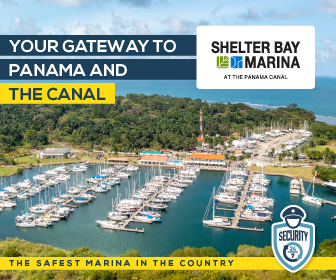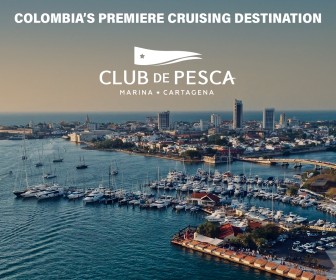Lessons we learnt in Colombia
Published 14 years ago, updated 6 years ago
Aruba to Colombia
We just did this trip two weeks ago and are in Cartagena now. A couple of lessons to pass on:
1. Zarpes
If you plan on stopping in Santa Marta, be sure your exit papers from Aruba list Santa Marta as your next stop, and NOT Cartagena. Listing on exit papers the furthest port you expect to stop it is a big problem area with Columbian regulations, even though it is normal procedure for all other countries. To rectify this, we followed instructions from our incompetent agents (see point #2) and wrote a letter explaining that we entered Santa Marta for…(various specific reasons they advised us to put down). This resulted in me and another boat spending 3hrs with a lawyer in the port captains office surrounded by heavily armed police. No English is spoken, and I still don’t fully understand why we were there, but things got very tense for a while.
One boat arriving with us made an error on their “explanation letter” and had to start over again. In exasperation, rather than re-write the whole letter, they simply wrote “bad weather” on the paper and handed it back to the agent. They had no further problems with customs, immigration or the port captain. So, if you do find yourself in Columbia in a port not listed on your zarpe, you might consider putting down bad weather as the reason. However, the marina manager told us that a few weeks previous, a boat cleared to Cartagena came into Santa Marta because of bad weather and ended up paying a $1,500USD fine before they got released.
We got our zarpe and left before more trouble occurred. But like I mention below, we are still dealing with the problem in Cartagena.
If you put down Santa Marta on your exit papers and then bypass it to go straight to Cartagena, you may also have problems.
Santa Marta
Although we had problems there, I need to point out that Santa Marta is a wonderful city with great people and I wholly recommend stopping there for a while. The marina is not complete yet, and there are few boats in it, so you can bargain fantastic rates with them. Shopping and excellent, inexpensive food is close to the marina, and the town seems to be constantly in festival mode.
2. Agents
The ONLY agent to get in Santa Marta is Dino (or another representative) from Edgar Romero’s agency. The marina will try to force you to take whichever agent happens to be on site at that particular time. ALL OTHER AGENTS ARE INCOMPETENT (or may be crooks, but let’s just say they are massively incompetent). Trust me on this, we dealt with all of them except Romero’s, and boats using Romero’s were the only ones without significant problems. We are still trying to solve legal problems here in Cartagena caused by incompetent agents in Santa Marta.
While on the topic of agents, be aware that they are not all equal and the ease in which you get your clearance/exit is highly dependent on their skills and knowledge. There can be differences in how much you pay for clearance but these differences in pricing may be achieved through an agent bending or ignoring rules and laws. This is important to understand in Columbia, as being caught on the wrong side of the law can be a very serious situation there for a cruiser. More so than other countries – particularly those in the Eastern Caribbean, where many cruisers arrive from. Any agent ignoring laws puts you and your boat at great risk and is not worth the extra couple of dollars savings.
3. Routing
While it is true that the waves pile up on the continental shelf, keeping well offshore is not the recommended way to travel from Aruba or along the Columbian coast. There is usually a compression zone between a LO over South America and an HI over North America that is located between 10 and 150 miles off the Columbian coast. Staying 150 miles offshore is an unreasonable route to Columbia since you will have to turn south at some time and take a lot of weather on the beam or even forward of it. And you will still need to traverse 100nm or so of the compression zone. Further, you won’t have any opt-out options if the weather turns bad.
So it is better to stay within 10nm of the coast. This route will keep you inside the compression zone and allow you several opportunities along the coast to hole up if the weather turns bad.
4. Weather
Pick your weather windows and wait for good ones. When you have one, go with it as far as you can. This is very important for this passage, particularly for the time of year you wish to make the passage. We waited a long time this year for a great 15-20kt run with 4-6′ gentle seas and went from Aruba to Santa Marta, then from Santa Marta to Cartagena with a quick overnight stop at Punta Hermosa. Two boats leaving Aruba at the same time as we made stops in the Monjes and Cabo de la Vela. That one day difference gave them a very unpleasant experience getting to Santa Marta the day after us. A boat arrived in Cartagena this morning dismasted because they pushed a weather window to get here.
A couple of general points:
- The 5 bays are open, but there has been at least one bad experience recently, as noted in another post.
- Going between the rocks and Aguja Island between the 5 bays and Santa Marta, as described in the Pizzaz guide, is a pucker experience if the weather is anything but calm. The wind and waves pick up here considerable due to local land/current effects – best to just go around the island itself if the weather is kicked up.
- We never saw less than 12′ going through the channel over the wall in Boca Grande, and that was for only a few feet before it became deep again. The channel is well marked.
- The guide on Club Nautico’s website is a little out of date, but John there just updated the printed copy and it is freely available in the office. He says he will update the web version soon.
Mark Cole and Michele Kelly
s/v REACH
Related to following destinations: Caribbean Coast (Colombia), Cartagena, Colombia, Santa Marta






